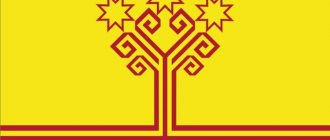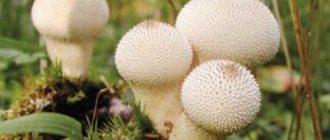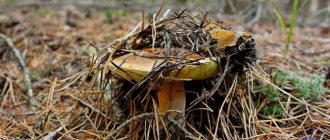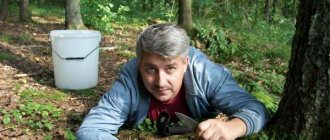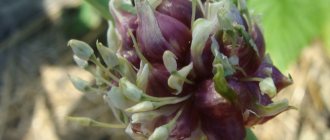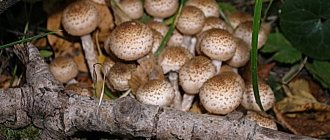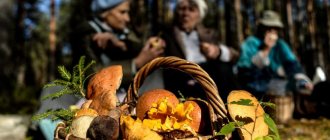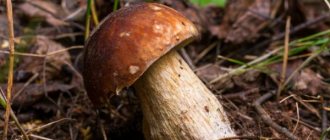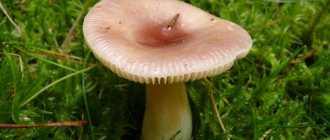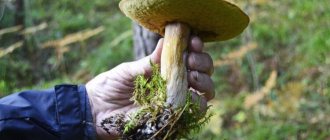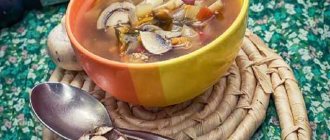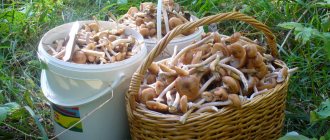What kind of harvest will there be this year?
Despite the fact that the peak of the season is still ahead, mushroom pickers for spring and summer picking have managed to form conclusions and make assumptions. On the city forum, in threads dedicated to mushroom picking, you can read many discussions about identical fruiting compared to last year. The abnormal heat did not have a very good effect on the germination of myceliums, making only meadow mushrooms and umbrellas available for collection. The remaining mushrooms, until the end of July, were almost impossible to detect. But even if a mushroom picker accidentally found a half-white mushroom, boletus or boletus, the flesh turned out to be wormy or rotten.
Predicting autumn fruiting is quite difficult; it all depends on the cyclone that comes in September, October and November, as well as the level of precipitation. In drought, it is almost impossible to detect mushrooms. The only exceptions to the rules include places bordering the coastline. Rivers, lakes and even swamps increase humidity, promoting germination even in summer.
To increase your chances, before going to the forest, you should carefully study the mushroom map, the exact coordinates or approximate directions left by other mushroom pickers under photos in VK groups dedicated to picking mushrooms and berries. It is worth taking other recommendations into account: weather conditions, humidity levels, clothing that protects from external factors and equipment necessary for collection. Only if you are fully prepared, a walk through the forest in combination with searching for a mushroom harvest will go quickly, with benefit for the gatherer.
Helpful information!
The mushroom map of Belarus was created over the course of a decade. Mycologists formed the correct route based on an annual survey of local residents who devote their free time to mushroom hunting. Real reviews about silent hunting made it possible to create the best directions for collecting edible and conditional mushrooms that germinate in both deciduous and coniferous deposits.
Based on the map of mushroom places, we can conclude that mushroom pickers get the most harvest in a mixed forest. Due to the germination of different trees, mushroom pickers manage to fill their baskets with assorted mushrooms containing a comprehensive list of useful vitamins, macro- and microelements.
Among the most popular places today are the territories located in the region of Minsk and Vitebsk:
- village of Ilya;
- Khatyn massif;
- forest areas near the village of Pleshchenitsa;
- village of Stolbtsy;
- forest near Talka station.
Mushrooms of Belarus, types + photos
Despite the diversity of mushrooms found on the territory of Belarus, among edible and conventional species, about 250 varieties are distinguished. Of these, even experienced mushroom pickers collect and know by their distinctive characteristics no more than 50.
Mushroom picking begins at the end of spring and lasts until the beginning of frost, approximately until November. If warm weather persists in winter, exceeding a temperature of 0 degrees, germination is delayed, allowing lovers of quiet hunting to collect not only porcini and oyster mushrooms, but also rare for the country - flammulina or winter honey fungus. Its bright red color stands out among the snow-white mound of snow, reducing a forest walk to a minimum, preventing the mushroom picker from freezing.
In the spring months, after the melt water has melted, the first to wake up are morels and strings, outwardly different from the classic representatives of the mushroom world. Their caps externally resemble the structure of a walnut and a honeycomb. The first ones are absolutely edible and safe, the second ones have poisonous varieties that are dangerous for consumption even after heat treatment and drying. Poisons and toxins in the pulp persist even after exposure to high temperatures.
Following the first mushrooms, the May row, mushrooms, champignons and boletus, and meadow mushrooms wake up. At the end of their fruiting, other mushrooms can be found in the forest thicket. From the end of August, the Assumption honey fungus begins to germinate, and then the autumn subspecies: thick-legged, royal, etc.
And although the peak months for mushroom germination are considered to be the autumn months, in the spring you can harvest no less tasty and healthy harvest. Calm occurs only in the summer: June, July and August, provided there is no rain and an abnormally hot summer, when the air temperature warms up above 23 degrees Celsius during the daytime.
You can increase the chances of success by taking into account weather conditions, the day of the week that reduces the number of people collecting, and the place of collection. Despite the rich forests of the country, local mushroom pickers, who have extensive experience in collecting, note increased fruiting only in a few zones. A map of mushroom places in Belarus will allow you to speed up your quiet hunt, collecting full baskets of protein products in just a few hours.
In Belarus, mushroom germination is divided into waves. The first falls in spring, the second in summer, and the third in autumn (in rare cases, winter). The latter is considered the richest, suitable for collecting fruits, both for food and preparations. The main advantages of the third wave are: the germination of various mushrooms, especially noble ones, favorable weather conditions, as well as a decrease in insects and snakes due to cold weather.
Mushroom picking, how to conduct a quiet hunt?
In order not to return from the forest with empty equipment and in a bad mood, you should adhere to a few simple rules, known for their effectiveness:
1) when planning a trip, it is recommended to give preference to the morning hours on weekdays. During working hours, the number of mushroom hunters is reduced, allowing local residents with a free work schedule and visiting guests to collect the maximum of edible and conditional gifts;
2) quiet hunting should begin in the forest thicket, where beginners rarely reach. Such advice will help avoid poisoning the body with toxins and carcinogens that permeate the fruit due to close germination to a highway or industrial zone;
3) when traveling to a new area or picking mushrooms for the first time, it is recommended to go mushroom hunting in the company of relatives, friends or acquaintances who are well versed in the edibility of fruits and the area;
4) in order to leave the mycelium intact and find mushrooms in a new zone a year later, it is not recommended to pull out the fruits along with the soil containing the mycelium. It is more correct to cut the leg at the base or unscrew it clockwise. Each of the methods is considered correct and has its admirers. The most important thing is that the mycelium is not damaged and continues to grow in the future. If all mushroom pickers do not follow the rules of collection, fruiting even in a rich mushroom place will be reduced to zero;
5) you can avoid a poisonous snake bite with the help of a long stick. With its help, it is easy to move away the foliage, making sure of the presence or absence of mushroom gifts. In addition, the recommendation will save your back from constant bending, facilitating the process to a minimum;
6) when collecting umbrellas, do not tear off just the hats. Cutting the stem will allow you to verify the edibility of the mushroom, casting aside doubts about the content of poisons in the pulp;
7) not all mushrooms germinate in families. Many noble breeds bear fruit singly, masquerading as the fauna of the area.
Poisonous and inedible mushrooms that are found in Belarus
When going into the forest, it is worth remembering that the republic is rich not only in edible mushrooms, but also in poisonous ones. They pose a mortal danger to humans.
False honey agaric
When going into nature, you can often stumble upon a large family of such honey mushrooms. The apex is bell-shaped if the mushroom is still young, and flat in adult specimens. The main difference is the reddish-yellow shade of the cap, which becomes more saturated and darker towards the center.
The cap is located on a thin, hollow stem, which has a fibrous structure. In this case, there is no specific ring, and the core of the mushroom is represented by bitter, unpleasant-smelling and yellowish pulp.
Death cap
An incredibly dangerous mushroom that has a lamellar structure and can cause life-threatening poisoning. The outer side of the cap is gray or olive in color, with a slightly convex or prostrate shape. The internal contents are white and have no characteristic taste or aroma. The white, cylindrical leg is distinguished by a thickening that forms at the very base of the dangerous mushroom.
fly agaric
It is almost impossible to confuse it with other varieties, since it is distinguished by the rich color of the cap (red, yellow, brown), on which white dots are visible. Young fly agarics are characterized by a hemispherical shape of the cap, while in older ones it becomes concave. It is held in place by a cylindrical, white or yellowish leg, which has a characteristic thickening at the base.
Pig
For a long period of time, the mushroom was included in the category of conditionally edible, but is now classified as a poisonous group. The pig is distinguished by a fleshy, slightly convex and flat, funnel-shaped, depressed cap with drooping, frilled or straight edges.
Its shade often varies from olive-brown to olive-brown in young specimens, while adults acquire a grayish-brown or rusty-brown undertone. The cap smoothly flows into the leg, which has a matte, smooth surface of a dirty yellow color. You can identify a dangerous mushroom by its pulp, which will begin to darken if you cut it.
Bile mushroom
The external texture is very similar to boletus, but its differences are the shape of the cap and the type of tubes. At a young age, the mushrooms are covered with a delicate fluff, which disappears as they grow older and the shell becomes smooth. The internal structure has a pink tint, which darkens when cut. The poisonous mushroom has no odor, but it has a bitter taste.
False chanterelles
Experienced mushroom pickers know that the real variety has “corrugated” edges, while the false ones are smooth and clear. It is equally important to pay attention to the condition of the fungus, namely how much it is affected by pests. Poisonous specimens are a favorite delicacy of worms, while real chanterelles are very rarely spoiled.
Pepper mushroom
The pepper mushroom, which is easily confused with an oil can, is also inedible. All their external characteristics are identical, the only difference is that the skin is not removed from the surface of the pepper mushroom, as it is completely fused with its body. It tastes like pepper, which is the basis for its name.
When going into the forests to pick mushrooms, you need to have an experienced person on your team, as well as read specialized literature on your own. A stock of knowledge will help you make the right choice and avoid poisoning from poisonous species.
How to protect your health? Basic Rules
In order not to remember with grief a quiet hunt, you should collect mushrooms according to the following rules:
1) when going to the forest area alone, you should take a compass and navigator with you. With their help, it will not be difficult to get out to the car or out of the thicket onto the road. You should also warn your family and friends, leaving the coordinates of the place where you decide to go;
2) to avoid bites from insects, snakes and ticks, do not neglect the spray and ointment that repel pests with their smell. Clothing should be closed, including items for a hiking look: a turtleneck with a neck, jeans, high rubber boots, a windbreaker, a cap or hat, depending on the time of year;
3) when leaving home, the smartphone should be fully charged, and there should be some money on the balance in order to contact loved ones in case of a problem. If you have a powebank, do not neglect its use;
4) to quench your thirst and hunger, you should take with you: tea in a thermos or coffee, 0.5 liters of water, sandwiches for a snack;
5) to prevent fatigue, you can stop every 30-40 minutes, taking five-minute breaks;
6) exclude from collection sites forest areas located near contaminated areas: cemeteries, highways, factories;
7) you should not pick mushrooms in places with increased levels of radiation;
refuse fruits that cause doubts and mistrust.
If a child is accompanying an adult, it is worth explaining to the little mushroom picker the rules of safety and behavior in the forest. A daughter or son, granddaughter or grandson should not leave their loved one, avoiding picking unknown mushrooms and berries, tasting the fruits of the forest.
Where do boletus grow?
Boletuses are the recognized kings of the forest. They can grow in any forest in groups or alone. Mushrooms in the forests of Belarus especially love places where there are blueberries, lingonberries, and fly agaric mushrooms. They love boletus and many anthills. If the boletus grew in a spruce forest, then it is a strong brown mushroom with light spots.
In a pine forest it is different - dark, sometimes the cap even has a purple tint. Mushrooms with a long stem, strong flesh and a light brown cap grow under birch and oak trees. Their leg is longer than that of other boletus mushrooms.
